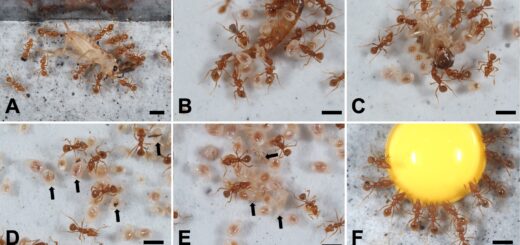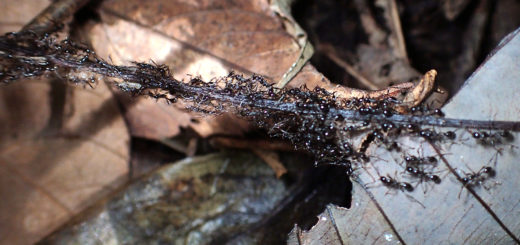Social regulation of insulin signaling in ants
In the paper “Social regulation of insulin signaling and the evolution of eusociality in ants” recently published in Science, Vikram Chandra, Ingrid Fetter-Pruneda, Peter R. Oxley, Amelia L. Ritger, Sean K. McKenzie, Romain Libbrecht, and Daniel J.C. Kronauer revealed that a single gene is up-regulated in ant reproductives compared with workers. This gene is likely important for queen status. In this contribution, selected snapshots of their study’s development are shown.
A Photoblog contribution compiled by Vikram Chandra and Ingrid Fetter-Pruneda
Ant queens and workers often have quite dramatic reproductive asymmetries. Here, you see an Eciton burchellii queen being tended by her much smaller daughter workers – the asymmetry is evident. (© Daniel Kronauer)

We wanted to know how this reproductive asymmetry is regulated, and how it evolved. To begin, we conducted a transcriptomics screen across the ant phylogeny to identify conserved candidate genes that could regulate the reproductive division of labour. We chose seven species of distantly related ants. A few of these already had published brain transcriptome data, but we travelled to south Florida (Lake Placid and Gainesville) to collect queens and workers from three other species: Odontomachus ruginodis, Camponotus planatus, and Solenopsis invicta. Surprisingly, we found that only a single gene was always consistently differentially expressed: ilp2, the ant version of insulin, which was always upregulated in ant queens (and other reproductive adults). See Fig. 1 from the paper.
To study the function of this gene, we turned to our model ant species, the clonal raider ant Ooceraea biroi. This is a doryline ant that has secondarily lost its queens. The workers are all totipotent and clonal, and they reproduce synchronously. The larvae suppress adult reproduction and induce brood care, leading to stereotyped colony reproductive cycles. Here, you see Ooceraea biroi interacting with larvae.


Larvae suppress adult reproduction by inactivating their ovaries. Here, you can see the inactivated ovaries (stained with DAPI) of a worker in a colony in the brood care phase.
Here, you see a 3D reconstruction of control ovaries.

We discovered that insulin is produced in 15 cells in the pars intercerebralis of the ant brain, and that larvae suppress insulin production. This is the brain of a worker, stained with an antibody against insulin (green), DAPI (blue), and phalloidin (magenta).

To test whether the regulation of insulin really explained the reproductive cycle in O. biroi, we injected synthetic insulin into ants in the brood care phase. We found that injecting synthetic insulin could override larval suppression, robustly activating the ovaries. This shows that insulin contributes to the reproductive asymmetry in O. biroi and very likely also in other ants (queens with high insulin can activate their ovaries, while workers with low insulin cannot). Here, you see a 3D reconstruction of activated ovaries.








Amazing discovery, great research!!!!